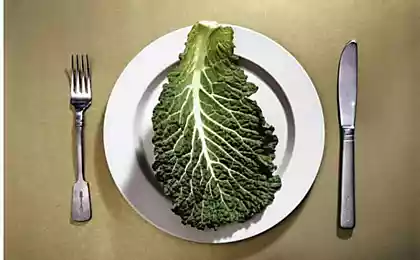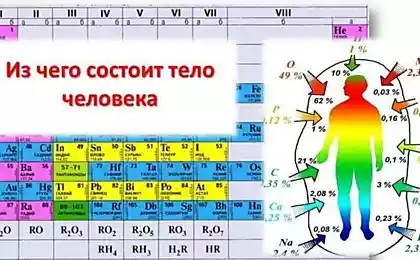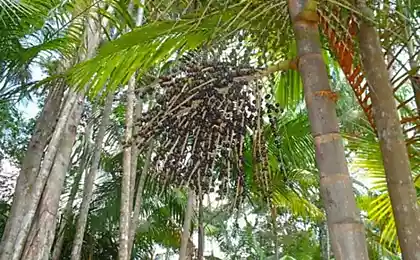725
A healthy balance of sodium-potassium in foods
Today will touch on a topic such as the ratio of sodium and potassium in the diet (refer to the illustrations: Potassium (K+, Potassium), Sodium (Na+, Sodium).
Strictly speaking, a safe amount of sodium depends on the receipt of potassium, health, it is important the right balance of sodium and potassium in foods, this ratio determines many of the targets: from the General tone to bone health and blood pressure. Let's deal.

Evolutionary mismatch.
Where did the problem of the relation of potassium and sodium? The answer to this gives the theory of inconsistency and research the lifestyle of our ancestors – hunter-gatherers.
Potassium (K+, Potassium), Sodium (Na+, Sodium) are the two most common in the cells of our body mineral. A substance that was rare during the Paleolithic, and is now available almost in excess — sodium chloride (sodium) salt. Sodium is absolutely essential for neurological and muscular functioning; without it is impossible the maintenance of life. The same can be said about potassium, but these two nutrients the body actively retains only the sodium.
When the sodium level in the body decreases, the adrenal cortex secretes a hormone called aldosteronethat makes the kidneys re-absorb the circulating sodium. The body lean in the ratio of sodium to potassium and wasteful. He has a huge detention mechanisms of sodium (renin-angiotensin-aldosterone system), but lacks mechanisms for active conservation and potassium excretion of excess sodium, so the lack of sodium is transferred easier, than its excess.

Although potassium is essential for life, in the body there is a complex physiological mechanisms to retain potassium. It is continuously excreted in the urine, especially under stress. These differences are a product of our evolutionary history. Except the sea coasts, ancient habitat was for the most part is devoid of salt.
Accordingly, our body requires sodium, and there are mechanisms for its retention. Away from sea sodium is found only in animal food, so the hunters could do without salt. But as people switched to agriculture, salt was a real treasure, as farmers began to consume much more plant foods and less animal and they have a serious shortage of salt (salt hunger).
On the other hand, the potassium usually found in plant foods, particularly in fruits. Hunter gatherer eating plant foods every day, so the nature has provided a mechanism for the accumulation and storage of potassium in our body. Potassium was always as a pervasive part of the environment that we have no special physiological adaptations to save it. We have never experienced the urgent need for such a mechanism, during its evolutionary past.
In the modern world, sodium is everywhere, and we usually consume sodium in much larger quantities than necessary. Modern man uses many plant products, but if uses, or very little or in a revised form with the addition of sodium (bread, etc.). In the end, the level of potassium in the body is minimal and the ratio of potassium to sodium is upside down.
What now? The balance of potassium-sodium.
Now we have absolutely opposite situation: the sodium is in excess, a huge amount of sodium is in the form of salt and in many additives (sodium sorbate, sodium benzoate, sodium glutamate, sodium ascorbate, sodium bicarbonate, etc.). And plant food we are eating much less or highly processed.
For example, tomato juice, salt, which is usually sold in stores, despite the fact that it contains large amounts of potassium, due to the fact that sodium there is usually 2 times bigger, in the end, we don't get potassium, because it neutralizes sodium.
Aggravates the situation and stress. Under stress our body begins to display even more potassium and accumulate sodium, worsening an already bad situation. In the end we have "flipped" the ratio of sodium and potassium in the modern diet that leads to many problems.
There is a close relationship between the metabolism of water and electrolytes. Due to the fact that potassium is readily excreted, and sodium is easily delayed it, we can talk about the known antagonism between potassium and sodium in relation to water exchange.
Potassium and sodium have the opposite effect on the water exchange in the body: potassium has a diuretic effect, sodium and water retention (sodium ions cause swelling of the colloids of the tissues). Foods rich in potassium causes increased sodium excretion from the body with water, it dissolves harmful salt surplus generated during metabolism. At the same time, the consumption of sodium-rich food in large quantities leads to loss of potassium and conservation in the body of metabolic products.
Normal intake of potassium in whole plant foods leads to the fact that they have relatively low frequency of diseases of the cardiovascular system. Also, in the diet that are low in sodium and is dominated by fruits and vegetables, hypertension is found in only 1% of the population.
While among the urban inhabitants hypertension is one of the most important health problems, affecting about a third of all urban residents. This is because urban residents to take food mostly especially processed foods that contain a lot of salt (sodium). For example, the average American daily intake of sodium in 2 times exceeds the norm, and potassium, on the contrary, in 2 times less than normal.
Studies have shown that a large amount of sodium in the diet was associated with an increased risk of death from any disease. "The people in the group with a high content of sodium in the diet had increased risk of death from any disease by 73% compared to less sodium consumption," said Kuklina.
Under higher sodium intake was made up of people whose diet contained 5000 mg of sodium per day. Those who consumed 4069 mg of potassium per day had a reduced risk of death from any disease by 49% compared to people who consumed 1793 mg of potassium a day. Large amounts of potassium in the diet reduced the risk of fatal heart disease.
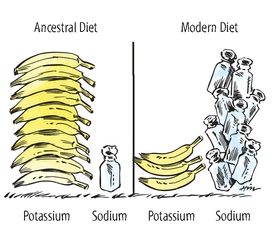
In assessing the sodium and potassium in the diet, scientists have found that people with the most unfavourable ratio (a lot of sodium and little potassium) had twice the risk of death from heart disease and a 50% greater risk of death from other diseases for surveillance. A normal intake of potassium prevents the formation of stones in the kidneys, the liver, the bile ducts. Potassium prevents calcium deposits in joints, blood vessels. Excess sodium causes fluid retention.
You need to remember about potassium-sodium balance. The fact that food rich in potassium, causing increased excretion of sodium, and Vice versa. If a person consumes foods primarily of plant origin, rich in potassium, do not forget about salt. Vegans who do sports and don't salt food, can make a serious deficiency of sodium in one to two weeks.
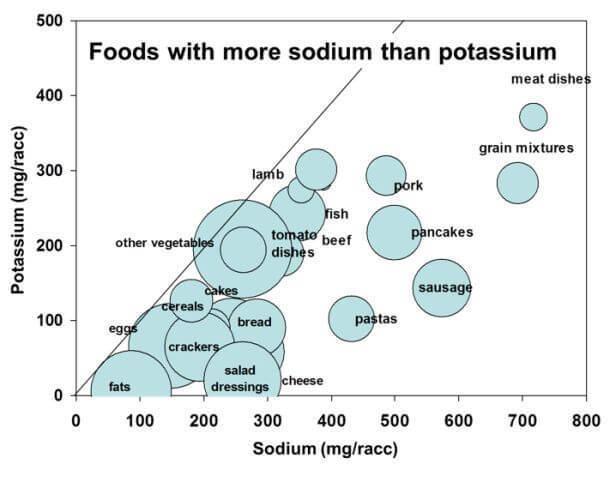
Manifestations of potassium deficiency.
Weakness and fatigue can be the most common indicator of a lack of potassium in the body. Leg cramps, especially those that Wake you up in the middle of the night, can also be associated with low levels of this mineral ( as well as magnesium and calcium).
The low-calorie diets and lovers of intense exercise are particularly susceptible to associated with potassium deficiency loss of energy. The same can be said about the elderly. Insufficient amount of potassium and magnesium can contribute to the development of chronic fatigue syndrome. Often the mere replenishment of minerals in the body with equal quantities (250-500 mg), organic salts of potassium and magnesium is enough to restore muscle tone, increase energy levels and increase endurance.
The results can often become noticeable after a week. If this Duo by itself does not help, it still can be a useful Supplement in the treatment of other types of fatigue.
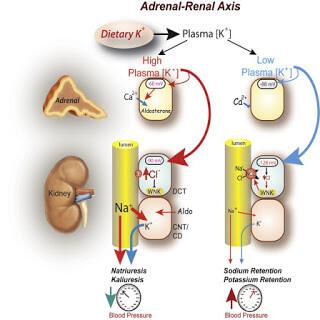
A sufficient amount of potassium is important for glycogen formation and protein metabolism. Thus, intracellular sequestration of potassium occurs in the formation of glycogen and protein: 1 g of glycogen in cells fed 0.3 mmol of K+ ions, 1 g of nitrogen protein binds 3 mmol K+.
This explains why changes in the balance of potassium and nitrogen in the organism is unidirectional. In the amplification of catabolic processes potassium and nitrogen are released from the cells, anabolic — linger in them. The exchange of potassium in the body regulate aldosterone and glucocorticoids: no decrease reabsorption of potassium in the distal tubules and contribute to its liberation from communication with proteins and carbohydrates.
Where to get potassium?
Whole plant food is a universal source of potassium. For example, potassium in foods is well absorbed, as very effective combination of glucose with insulin, which promotes the transfer of potassium into cells. The daily requirement of potassium for an adult is 2-5 g a day sodium – 1 to 2 g.
At high physical and mental stress, pregnancy and nutrition with a large number of salts the need for potassium increases. Children necessary to calculate the required amount of potassium, based on their weight: 16-30 mg per kilogram. Official figures from the Manual of nutrition (USA): consumption of sodium to 1,500 mg per day and potassium is 4700 mg per day.
In most physiological processes potassium acts as an antagonist of sodium (Na), so, to maintain good health it is necessary that the ratio of sodium to potassium in the diet was 1:2 and 1:4. Harmful excess sodium in the body can neutralize the introduction of additional quantities of potassium. This is based on the therapy of edematous States diet, rich in potassium.
Vegetables and fruits contain a lot of potassium and little sodium. For example, one fruit of avocado contains a gram of potassium. Products-Champions in potassium: peas, soybeans, beans, lentils, nuts, dried fruits, dried porcini mushrooms, eggplant, Brussels sprouts, red, kohlrabi, potatoes, parsley, parsnips, rhubarb, radish, radish, turnip, lettuce, celery, beets, tomatoes and tomato paste, dill, garlic, horseradish, spinach, sorrel
Conclusion.
Potassium in the human body – the antithesis of sodium. These two elements are involved in the same biochemical processes, but with different vector. The lack of one of these elements leads to an excess of the other and, consequently, to fail in certain systems of the body. The sodium and potassium balance in the body plays an important role in the formation of our health, and what foods will be the main source of maintaining this balance.
Following the diet based on the balance of sodium and potassium, we will strengthen and will help to function your own muscles and nervous tissues (the muscles, which account for special load, need a plentiful supply of both minerals). The body will be better to maintain acid-base balance and water-mineral.
The sodium and potassium balance is more important than the observance of a specific number.
Scientific literature shows that potassium in whole plant foods can be much more important for the treatment and prevention of several diseases.published
Author: Andrey Blueskin
P. S. And remember, only by changing their consumption — together we change the world! ©
Join us in Facebook , Vkontakte, Odnoklassniki
Source: www.beloveshkin.com/2016/02/zdorovyj-balans-natrij-kalij-v-produktakh-pitaniya.html
Strictly speaking, a safe amount of sodium depends on the receipt of potassium, health, it is important the right balance of sodium and potassium in foods, this ratio determines many of the targets: from the General tone to bone health and blood pressure. Let's deal.

Evolutionary mismatch.
Where did the problem of the relation of potassium and sodium? The answer to this gives the theory of inconsistency and research the lifestyle of our ancestors – hunter-gatherers.
Potassium (K+, Potassium), Sodium (Na+, Sodium) are the two most common in the cells of our body mineral. A substance that was rare during the Paleolithic, and is now available almost in excess — sodium chloride (sodium) salt. Sodium is absolutely essential for neurological and muscular functioning; without it is impossible the maintenance of life. The same can be said about potassium, but these two nutrients the body actively retains only the sodium.
When the sodium level in the body decreases, the adrenal cortex secretes a hormone called aldosteronethat makes the kidneys re-absorb the circulating sodium. The body lean in the ratio of sodium to potassium and wasteful. He has a huge detention mechanisms of sodium (renin-angiotensin-aldosterone system), but lacks mechanisms for active conservation and potassium excretion of excess sodium, so the lack of sodium is transferred easier, than its excess.

Although potassium is essential for life, in the body there is a complex physiological mechanisms to retain potassium. It is continuously excreted in the urine, especially under stress. These differences are a product of our evolutionary history. Except the sea coasts, ancient habitat was for the most part is devoid of salt.
Accordingly, our body requires sodium, and there are mechanisms for its retention. Away from sea sodium is found only in animal food, so the hunters could do without salt. But as people switched to agriculture, salt was a real treasure, as farmers began to consume much more plant foods and less animal and they have a serious shortage of salt (salt hunger).
On the other hand, the potassium usually found in plant foods, particularly in fruits. Hunter gatherer eating plant foods every day, so the nature has provided a mechanism for the accumulation and storage of potassium in our body. Potassium was always as a pervasive part of the environment that we have no special physiological adaptations to save it. We have never experienced the urgent need for such a mechanism, during its evolutionary past.
In the modern world, sodium is everywhere, and we usually consume sodium in much larger quantities than necessary. Modern man uses many plant products, but if uses, or very little or in a revised form with the addition of sodium (bread, etc.). In the end, the level of potassium in the body is minimal and the ratio of potassium to sodium is upside down.
What now? The balance of potassium-sodium.
Now we have absolutely opposite situation: the sodium is in excess, a huge amount of sodium is in the form of salt and in many additives (sodium sorbate, sodium benzoate, sodium glutamate, sodium ascorbate, sodium bicarbonate, etc.). And plant food we are eating much less or highly processed.
For example, tomato juice, salt, which is usually sold in stores, despite the fact that it contains large amounts of potassium, due to the fact that sodium there is usually 2 times bigger, in the end, we don't get potassium, because it neutralizes sodium.
Aggravates the situation and stress. Under stress our body begins to display even more potassium and accumulate sodium, worsening an already bad situation. In the end we have "flipped" the ratio of sodium and potassium in the modern diet that leads to many problems.
There is a close relationship between the metabolism of water and electrolytes. Due to the fact that potassium is readily excreted, and sodium is easily delayed it, we can talk about the known antagonism between potassium and sodium in relation to water exchange.
Potassium and sodium have the opposite effect on the water exchange in the body: potassium has a diuretic effect, sodium and water retention (sodium ions cause swelling of the colloids of the tissues). Foods rich in potassium causes increased sodium excretion from the body with water, it dissolves harmful salt surplus generated during metabolism. At the same time, the consumption of sodium-rich food in large quantities leads to loss of potassium and conservation in the body of metabolic products.
Normal intake of potassium in whole plant foods leads to the fact that they have relatively low frequency of diseases of the cardiovascular system. Also, in the diet that are low in sodium and is dominated by fruits and vegetables, hypertension is found in only 1% of the population.
While among the urban inhabitants hypertension is one of the most important health problems, affecting about a third of all urban residents. This is because urban residents to take food mostly especially processed foods that contain a lot of salt (sodium). For example, the average American daily intake of sodium in 2 times exceeds the norm, and potassium, on the contrary, in 2 times less than normal.
Studies have shown that a large amount of sodium in the diet was associated with an increased risk of death from any disease. "The people in the group with a high content of sodium in the diet had increased risk of death from any disease by 73% compared to less sodium consumption," said Kuklina.
Under higher sodium intake was made up of people whose diet contained 5000 mg of sodium per day. Those who consumed 4069 mg of potassium per day had a reduced risk of death from any disease by 49% compared to people who consumed 1793 mg of potassium a day. Large amounts of potassium in the diet reduced the risk of fatal heart disease.

In assessing the sodium and potassium in the diet, scientists have found that people with the most unfavourable ratio (a lot of sodium and little potassium) had twice the risk of death from heart disease and a 50% greater risk of death from other diseases for surveillance. A normal intake of potassium prevents the formation of stones in the kidneys, the liver, the bile ducts. Potassium prevents calcium deposits in joints, blood vessels. Excess sodium causes fluid retention.
You need to remember about potassium-sodium balance. The fact that food rich in potassium, causing increased excretion of sodium, and Vice versa. If a person consumes foods primarily of plant origin, rich in potassium, do not forget about salt. Vegans who do sports and don't salt food, can make a serious deficiency of sodium in one to two weeks.

Manifestations of potassium deficiency.
Weakness and fatigue can be the most common indicator of a lack of potassium in the body. Leg cramps, especially those that Wake you up in the middle of the night, can also be associated with low levels of this mineral ( as well as magnesium and calcium).
The low-calorie diets and lovers of intense exercise are particularly susceptible to associated with potassium deficiency loss of energy. The same can be said about the elderly. Insufficient amount of potassium and magnesium can contribute to the development of chronic fatigue syndrome. Often the mere replenishment of minerals in the body with equal quantities (250-500 mg), organic salts of potassium and magnesium is enough to restore muscle tone, increase energy levels and increase endurance.
The results can often become noticeable after a week. If this Duo by itself does not help, it still can be a useful Supplement in the treatment of other types of fatigue.

A sufficient amount of potassium is important for glycogen formation and protein metabolism. Thus, intracellular sequestration of potassium occurs in the formation of glycogen and protein: 1 g of glycogen in cells fed 0.3 mmol of K+ ions, 1 g of nitrogen protein binds 3 mmol K+.
This explains why changes in the balance of potassium and nitrogen in the organism is unidirectional. In the amplification of catabolic processes potassium and nitrogen are released from the cells, anabolic — linger in them. The exchange of potassium in the body regulate aldosterone and glucocorticoids: no decrease reabsorption of potassium in the distal tubules and contribute to its liberation from communication with proteins and carbohydrates.
Where to get potassium?
Whole plant food is a universal source of potassium. For example, potassium in foods is well absorbed, as very effective combination of glucose with insulin, which promotes the transfer of potassium into cells. The daily requirement of potassium for an adult is 2-5 g a day sodium – 1 to 2 g.
At high physical and mental stress, pregnancy and nutrition with a large number of salts the need for potassium increases. Children necessary to calculate the required amount of potassium, based on their weight: 16-30 mg per kilogram. Official figures from the Manual of nutrition (USA): consumption of sodium to 1,500 mg per day and potassium is 4700 mg per day.
In most physiological processes potassium acts as an antagonist of sodium (Na), so, to maintain good health it is necessary that the ratio of sodium to potassium in the diet was 1:2 and 1:4. Harmful excess sodium in the body can neutralize the introduction of additional quantities of potassium. This is based on the therapy of edematous States diet, rich in potassium.
Vegetables and fruits contain a lot of potassium and little sodium. For example, one fruit of avocado contains a gram of potassium. Products-Champions in potassium: peas, soybeans, beans, lentils, nuts, dried fruits, dried porcini mushrooms, eggplant, Brussels sprouts, red, kohlrabi, potatoes, parsley, parsnips, rhubarb, radish, radish, turnip, lettuce, celery, beets, tomatoes and tomato paste, dill, garlic, horseradish, spinach, sorrel
Conclusion.
Potassium in the human body – the antithesis of sodium. These two elements are involved in the same biochemical processes, but with different vector. The lack of one of these elements leads to an excess of the other and, consequently, to fail in certain systems of the body. The sodium and potassium balance in the body plays an important role in the formation of our health, and what foods will be the main source of maintaining this balance.
Following the diet based on the balance of sodium and potassium, we will strengthen and will help to function your own muscles and nervous tissues (the muscles, which account for special load, need a plentiful supply of both minerals). The body will be better to maintain acid-base balance and water-mineral.
The sodium and potassium balance is more important than the observance of a specific number.
Scientific literature shows that potassium in whole plant foods can be much more important for the treatment and prevention of several diseases.published
Author: Andrey Blueskin
P. S. And remember, only by changing their consumption — together we change the world! ©
Join us in Facebook , Vkontakte, Odnoklassniki
Source: www.beloveshkin.com/2016/02/zdorovyj-balans-natrij-kalij-v-produktakh-pitaniya.html
5 ways to use pine resin, which You did not know
How to learn to write with both hands simultaneously




